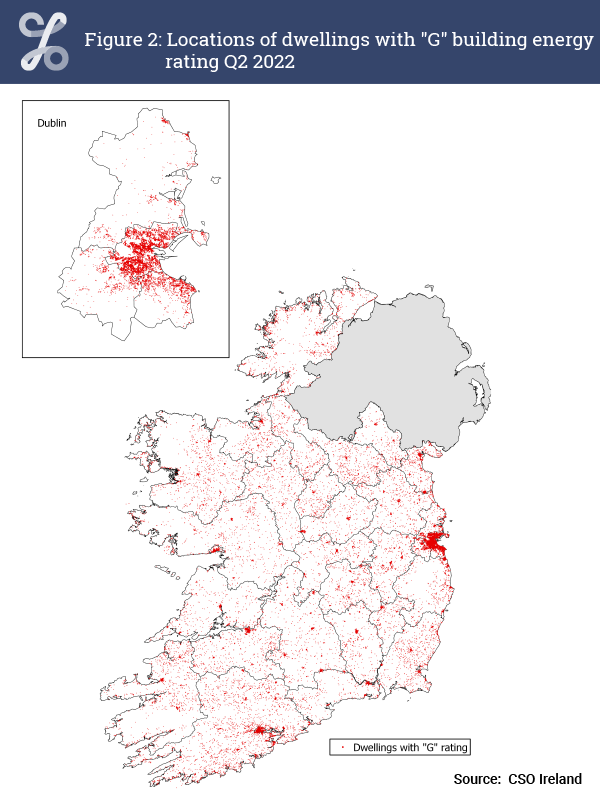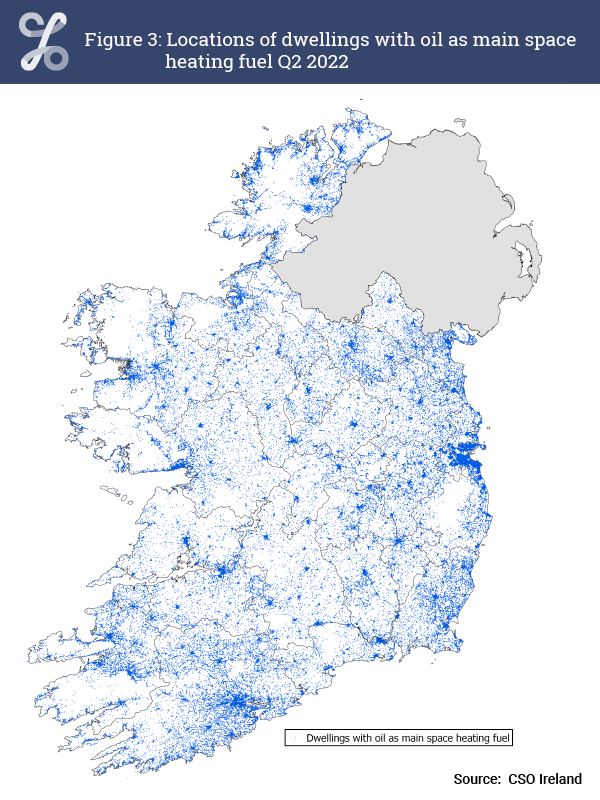The number of Building Energy Ratings (BER) audits performed in certain months have been adversely impacted by the COVID-19 pandemic. For further information please see the SEAI website.
Electricity was the main space heating fuel used in 82% of the dwellings with a Building Energy Rating (BER) audit and with construction completed during 2020-2022
There was an increase of 40% in the number of BER audits reported in Q2 2022 compared with Q2 2021
Dwellings built in 2015-2019 and 2020-2022 were considerably more energy efficient than those built in earlier periods with 96% and 99% respectively given an “A” rating
Dublin County had the highest combined “A” and “B” rating at 33% while Leitrim and Roscommon had the lowest proportion of combined “A” and “B” rating at 12%
Dublin 18 had the highest proportion of combined “A” and “B” rating at 48% and Dublin 7 had the highest proportion of combined “F” and “G” rating at 25%
| Table A: Main Space Heating Fuel by Period of Construction (2000-2022) | ||||
| % of row | number | |||
| Period of Construction | Mains Gas | Heating Oil | Electricity | BER audits |
| 2000-2004 | 41% | 36% | 19% | 174,901 |
| 2005-2009 | 45% | 31% | 18% | 161,276 |
| 2010-2014 | 49% | 30% | 17% | 11,866 |
| 2015-2019 | 47% | 5% | 48% | 52,523 |
| 2020-2022 | 17% | 0% | 82% | 28,255 |
| Mains Gas | Heating Oil | Electricity | |
| 2000-2004 | 41 | 36 | 19 |
| 2005-2009 | 45 | 31 | 18 |
| 2010-2014 | 49 | 30 | 17 |
| 2015-2019 | 47 | 5 | 48 |
| 2020-2022 | 17 | 0 | 82 |


| Earliest | Latest | |
| A | 0 | 3 |
| B1 | 1 | 3 |
| B2 | 2 | 6 |
| B3 | 5 | 14 |
| C1 | 8 | 17 |
| C2 | 11 | 15 |
| C3 | 12 | 12 |
| D1 | 14 | 10 |
| D2 | 13 | 8 |
| E1 | 9 | 4 |
| E2 | 7 | 3 |
| F | 8 | 2 |
| G | 10 | 2 |
| National Data | BER Database | |
| A | 7 | 10 |
| B1 | 1 | 2 |
| B2 | 3 | 3 |
| B3 | 7 | 8 |
| C1 | 10 | 11 |
| C2 | 12 | 12 |
| C3 | 12 | 12 |
| D1 | 12 | 11 |
| D2 | 11 | 10 |
| E1 | 6 | 6 |
| E2 | 5 | 4 |
| F | 6 | 5 |
| G | 8 | 7 |
1Dwellings with BERs have been weighted using 2016 Census of Population data to estimate a BER profile for All Dwellings at National level (see Background Notes).
| A | B | C | D | E | F-G | |
| 1700-1977 | 1 | 5 | 19 | 24 | 19 | 31 |
| 1978-1999 | 1 | 8 | 41 | 34 | 11 | 5 |
| 2000-2004 | 0 | 13 | 60 | 20 | 5 | 2 |
| 2005-2009 | 1 | 37 | 50 | 9 | 2 | 1 |
| 2010-2014 | 33 | 58 | 7 | 2 | 0 | 0 |
| 2015-2019 | 96 | 3 | 0 | 0 | 0 | 0 |
| 2020-2022 | 99 | 1 | 0 | 0 | 0 | 0 |
Statistician's Comment
Commenting on the release Dympna Corry, Statistician in the Environment and Climate Division, said:" Electricity was the main space heating fuel used in 82% of the dwellings with construction completed during 2020-2022 and with a Building Energy Rating (BER) audit. This was a substantial increase from buildings constructed during 2015-2019 when 48% of dwellings with a BER audit used electricity. There was a contrasting trend for mains gas with 17% of 2020-2022 built dwellings using mains gas compared with 47% for dwellings built in 2015-2019. There was also a contrasting trend for heating oil with 0% of 2020-2022 built dwellings using heating oil compared with 5% for dwellings built in 2015-2019.
There were 30,700 BER audits reported in Q2 2022 compared with 21,974 in Q2 2021. April 2022 was 40% higher than April 2021. May 2022 was a similar 42% above May 2021. The number of completed BER audits in June 2022 was 38% above the number in June 2021. In the period 2009 to June 2022 1.2 million BER audits have been undertaken.
Dwellings built in 2015-2019 and 2020-2022 were considerably more energy efficient than those built in earlier periods with 96% and 99% respectively given an “A” rating compared with 33% in 2010-2014 and 1% in 2005-2009.
Dublin County had the highest combined “A” and “B” rating at 33%. Leitrim and Roscommon had the lowest proportion of combined “A” and “B” rating at 12%.
Dublin 18, with an average dwelling age of 18 years, had the highest proportion of combined “A” and “B” rating at 48%. The average age of dwellings in Dublin 15 that have had a BER audit was also 18 years, but the combined "A" and "B" rating was much lower at 35% than in Dublin 18. The highest proportion of combined “F” and “G” rating was 25% for Dublin 7.
The average floor area of all dwellings with a BER audit was 113 square metres. This average size varied from 161 square metres for detached houses to 60 square metres for basement dwellings.
In their earliest assessment only 8% of dwellings that have had more than one BER audit carried out received either an “A” or “B” rating compared with 26% in their most recent assessment. In contrast, 18% of dwellings were rated “F” or "G" in their first BER assessment compared with only 4% in their latest BER assessment.
The national level data weighted using Census of Population 2016 figures shows that 6% of dwellings in Ireland would have received a rating of “F” compared with 5% of dwellings that have had a BER assessment. Similarly, 8% of dwellings would have received a rating of "G" compared with 7% of dwellings in the actual BER data. In contrast, 7% of dwellings would have received an "A" rating at the national level, whereas 10% of dwellings that have had a BER assessment were given an "A" rating.
Figure 2 shows the geographical location of dwellings with a "G" energy rating. Inner city areas have a higher proportion of "G" ratings than newer suburban areas. In contrast, Figure 3 shows that rural areas have a much higher percentage of dwellings using oil central heating."